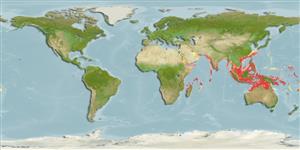Environment: milieu / climate zone / depth range / distribution range
ນິເວດວິທະຍາ
ສັດທະເລ ກ່ຽວກັນຫີນ; ລະດັບຄວາມເລິກ 20 - 200 m (Ref. 11441). Tropical; 30°N - 19°S
Indo-West Pacific: Persian Gulf to the western coast of India, eastward to the Pacific, where it occurs from Taiwan southward to the Arafura Sea (Ref. 9819) and northern Queensland, Australia (Ref. 3414).
Length at first maturity / ຂະໜາດ / ນ້ຳໜັກ / Age
Maturity: Lm 21.1 range ? - ? cm
Max length : 35.0 cm TL ຕົວຜູ້/ບໍ່ມີເພດ; (Ref. 11441); common length : 25.0 cm TL ຕົວຜູ້/ບໍ່ມີເພດ; (Ref. 3483)
Inhabits coral or rocky areas. Sometimes forms aggregations. Feeds on a wide variety of benthic animals. Smaller fish are mostly found inshore. Marketed mostly fresh, whole or dried-salted.
Starnes, W.C., 1988. Revision, phylogeny and biogeographic comments on the circumtropical marine percoid fish family Priacanthidae. Bull. Mar. Sci. 43(2):117-203. (Ref. 5403)
IUCN Red List Status (Ref. 130435)
Threat to humans
Harmless
Human uses
ການປະມົງ: ທີ່ເປັນການຄ້າໜ້ອຍ
ຂໍ້ມູນຕື່ມອີກ
ເອກະສານອ້າງອີງການລ້ຽງສັດນ້ຳຂໍ້ມູນການລ້ຽງສັດນ້ຳສາຍພັນກຳມະພັນElectrophoresesການຖ່າຍທອດທາງກຳມະພັນຈາກພໍ່ແມ່ຫາລູກພະຍາດການປຸງແຕ່ງNutrientsMass conversion
ຜູ້ຮ່ວມມືຮູບStamps, Coins Misc.ສຽງຫອຍມີພິດຊະນິດນຶ່ງທີ່ອາໄສໃນທະເລຄວາມໄວປະເພດການລອຍເນື້ອທີ່ເຫືອກOtolithsສະໝອງວິໄສທັດ
ເຄື່ອງມື
Special reports
Download XML
ແຫຼ່ງອີນເຕີເນັດ
Estimates based on models
Preferred temperature (Ref.
123201): 21.9 - 28.3, mean 26.8 °C (based on 847 cells).
Phylogenetic diversity index (Ref.
82804): PD
50 = 0.5002 [Uniqueness, from 0.5 = low to 2.0 = high].
Bayesian length-weight: a=0.02138 (0.01571 - 0.02910), b=2.90 (2.82 - 2.98), in cm total length, based on LWR estimates for this species (Ref.
93245).
ຊັ້ນເຂດຮ້ອນ (Ref.
69278): 3.8 ±0.3 se; based on diet studies.
Generation time: 1.6 (0.9 - 1.8) years. Estimated as median ln(3)/K based on 10
growth studies.
ຄວາມຢືດຢຸ່ນ (Ref.
120179): ສູງ, ປະຊາກອນຕຳ່ສຸດທີ່ໃຊ້ເວລາສອງໜ້ອຍກວ່າ 15 ເດືອນ (K=0.6-1.23).
Fishing Vulnerability (Ref.
59153): Low vulnerability (23 of 100).
Nutrients (Ref.
124155): Calcium = 53.2 [33.9, 86.8] mg/100g; Iron = 0.65 [0.42, 1.03] mg/100g; Protein = 19.3 [18.3, 20.3] %; Omega3 = 0.176 [0.124, 0.251] g/100g; Selenium = 45.4 [28.3, 74.4] μg/100g; VitaminA = 61.3 [25.2, 151.0] μg/100g; Zinc = 1.08 [0.80, 1.46] mg/100g (wet weight);
